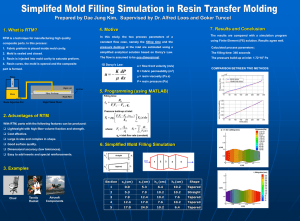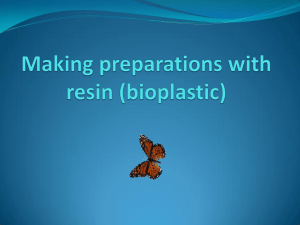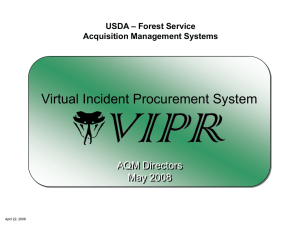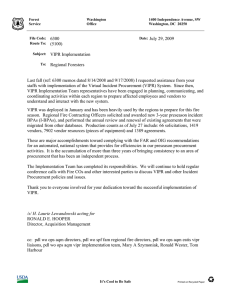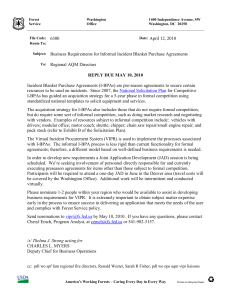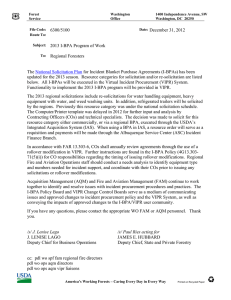development of computer controlled flow manipulation for
advertisement
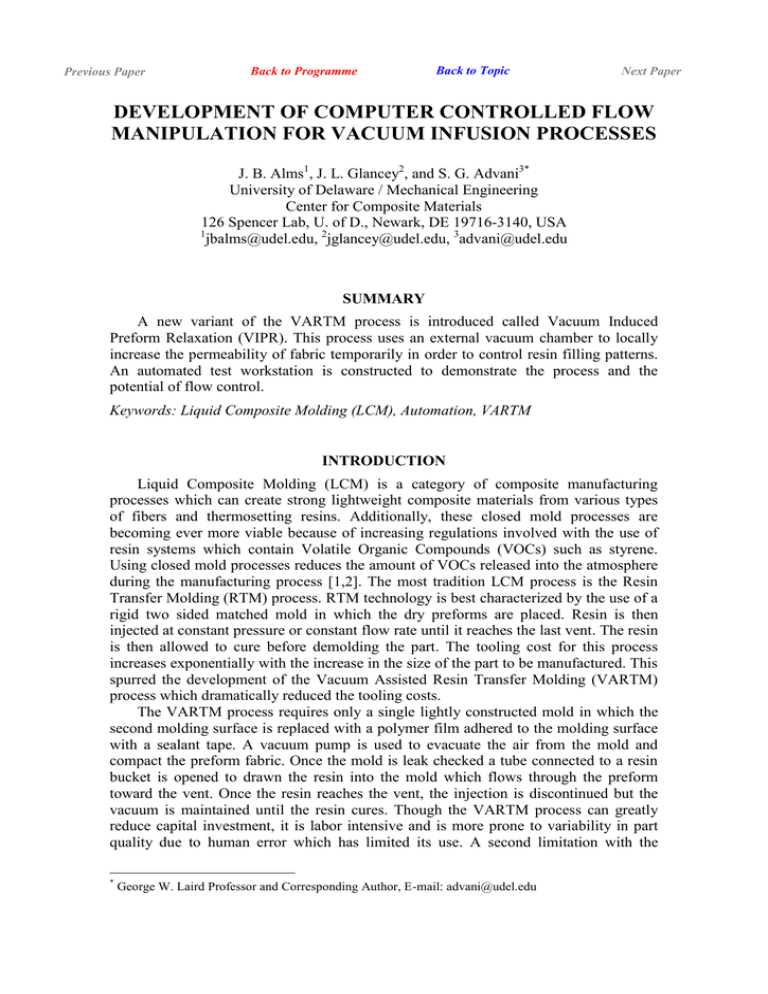
Previous Paper Back to Programme Back to Topic Next Paper DEVELOPMENT OF COMPUTER CONTROLLED FLOW MANIPULATION FOR VACUUM INFUSION PROCESSES J. B. Alms1, J. L. Glancey2, and S. G. Advani3* University of Delaware / Mechanical Engineering Center for Composite Materials 126 Spencer Lab, U. of D., Newark, DE 19716-3140, USA 1 jbalms@udel.edu, 2jglancey@udel.edu, 3advani@udel.edu SUMMARY A new variant of the VARTM process is introduced called Vacuum Induced Preform Relaxation (VIPR). This process uses an external vacuum chamber to locally increase the permeability of fabric temporarily in order to control resin filling patterns. An automated test workstation is constructed to demonstrate the process and the potential of flow control. Keywords: Liquid Composite Molding (LCM), Automation, VARTM INTRODUCTION Liquid Composite Molding (LCM) is a category of composite manufacturing processes which can create strong lightweight composite materials from various types of fibers and thermosetting resins. Additionally, these closed mold processes are becoming ever more viable because of increasing regulations involved with the use of resin systems which contain Volatile Organic Compounds (VOCs) such as styrene. Using closed mold processes reduces the amount of VOCs released into the atmosphere during the manufacturing process [1,2]. The most tradition LCM process is the Resin Transfer Molding (RTM) process. RTM technology is best characterized by the use of a rigid two sided matched mold in which the dry preforms are placed. Resin is then injected at constant pressure or constant flow rate until it reaches the last vent. The resin is then allowed to cure before demolding the part. The tooling cost for this process increases exponentially with the increase in the size of the part to be manufactured. This spurred the development of the Vacuum Assisted Resin Transfer Molding (VARTM) process which dramatically reduced the tooling costs. The VARTM process requires only a single lightly constructed mold in which the second molding surface is replaced with a polymer film adhered to the molding surface with a sealant tape. A vacuum pump is used to evacuate the air from the mold and compact the preform fabric. Once the mold is leak checked a tube connected to a resin bucket is opened to drawn the resin into the mold which flows through the preform toward the vent. Once the resin reaches the vent, the injection is discontinued but the vacuum is maintained until the resin cures. Though the VARTM process can greatly reduce capital investment, it is labor intensive and is more prone to variability in part quality due to human error which has limited its use. A second limitation with the * George W. Laird Professor and Corresponding Author, E-mail: advani@udel.edu VARTM process is the inherent permeability variations within the preform which often leads to resin filling patterns that leave dry unfilled regions with the mold. To address this deficiency, recent research into the process has provided an improved understanding and subsequently a greater potential to enhance the consistency of the manufactured parts. Introduction of computer controlled automation will increase the reliability and repeatability of the VARTM process which is the subject of this paper. Developments in automating in the VARTM process have ranged from cutting the fabric to demolding of the finished parts. One of the most crucial parts of the VARTM process is the filling process. If the resin infusion process does not occur as planned, the part is usually scraped. Therefore research has strongly focused on this aspect of the process. Various methods of controlling the resin infusion process have been proposed and studied such as automated heat induction [3-5], port injection [6], sequential injection [7], and recently the approach taken in this paper; Vacuum Induced Preform Relaxation (VIPR) [8]. THE VIPR PROCESS The VIPR process is a variant of the VARTM process with a single major additional element and has been previously documented [8]. The VIPR process uses a secondary vacuum chamber which can create a seal on the bag surface of a vacuum infusion process mold. This extra vacuum chamber is relatively small compared to the total size of the mold and can be placed directly over an injection port drilled into the tooling surface. When a regulated vacuum source is applied to the chamber, in the range of 0-0.2 bar, the affected region of fabric relaxes and becomes more permeable. A schematic of the chamber, herein referred to as the VIPR chamber, is shown in Figure 1. Figure 1: Left: Top View of the VIPR chamber. Right: Cross- sectional view of the left schematic. During a vacuum infusion process the VIPR chamber shown in Figure 1, can be placed onto the mold so that the foam forms an airtight seal against the bag surface. Once the vacuum source is applied, the vacuum causes the fabric under the chamber to become less compact and thus more permeable. When the chamber is specifically placed around an injection port, the VIPR chamber can have a profound effect on where and how the resin enters the mold. With the increased understanding of this effect, the flow can manipulated be steered to ensure complete filling of any given structure. The objective of this paper is to present the development of a new vacuum based infusion workstation that utilizes the VIPR process. Using this workstation, lab experiments are used to demonstrate the potential benefits of this new process in controlling resin flow during infusion. WORKSTATION DESIGN To test and validate the ability of VIPR process to control resin flow front patterns and more importantly in an automated manner to influence vacuum infusion processes, an experimental vacuum infusion test bed was created. The workstation is schematically shown in Figure 2, and was constructed as a major advancement of a previous Figure 2: Cross-sectional schematic of the VIPR process workstation. All of the major hardware is labeled. For clarity this schematic does not depict the actual arrangement of hardware but a simplification of the real workstation. workstation built for testing the RTM process. The design and details of this previous workstation have previously been reported [9-11]. The workstation shown in Figure 2 includes a VIPR chamber and controls various aspects of the infusions process. In this workstation, the most significant feature is the ability to spatially control the injection of resin by deploying the chamber in a manner to change the resin flow patterns. In the schematic there are three pneumatic pistons mounted to the bottom plate. Two of these pistons are connected to the resin inlet ports and control the injection of resin into the mold. The third piston is used to vent the gas from the mold. The introduction of a vacuum tub is a key modification which allows the pistons to open and close the ports when the mold is under vacuum pressure. The vacuum tub equalizes the pressure on both sides of the silicone membrane so that it remains undisturbed when the mold is under vacuum. The VIPR process is implemented into this workstation by motion control of the VIPR Chamber. A gantry system consisting of linear actuators, stepper motors, a motor controller, and lastly one pneumatic piston are able to control within limits the position of the VIPR Chamber. The linear actuators control the planar motion while the Chamber Piston controls the ability to firmly press the VIPR Chamber against the mold surface. The chamber motion is invoked by feedback from the camera mounted above the mold surface as shown in Figure 3. Lastly, the regulated vacuum pressure applied to the VIPR Figure 3: Left: Photograph of the workstation gantry control system and workstation. Right: Close up photograph of the camera mounted to the top of the gantry structure. Chamber is controlled by coupled system of a Solenoid Valve and a manually tuned Vacuum Pressure Regulator. The Solenoid Valve allows the VIPR Chamber to either be under a regulated pressure or atmospheric pressure. A digital camera is mounted to the frame structure above the mold to monitor resin flow front progression. Analysis of photographs taken with the camera is used to decide on appropriate control actions. Lastly, all of these subsystems are connected to a single computer with control integrated into a program written with LabView. VALIDATION OF ONLINE FLOW ACTUATION AND CONTROL To validate the implementation, all the subsystems shown in the previous section are used in combination to demonstrate an example case in which online control is used to drastically reduce the unfilled area. The goal of this experiment is to show that using the VIPR process in conjunction with the newly improved workstation can effectively manipulate resin flow patterns to assure that the vent location is always in the vicinity of the last region in the mold to be filled independent of flow disturbances. In this work an online control strategy is adopted for a pre-defined arrangement of injection gates with a single off centered vent in a square mold to demonstrate the approach of automated resin steering towards the vent with the actuation of the chamber based on a feedback from a camera mounted above the mold surface. Mold Surface A square mold with four gates and an off centered vent which uses the pre-existing arrangement of gates and vents already built into the workstation mold surface is selected as shown in Figure 4. The vent selected was placed off center to demonstrate Figure 4: Location of the gates and off centered vent on the workstation mold surface for selected experiment to demonstrate flow control. the capability of the workstation to steer resin flow to assure complete filling in nonsymmetric situations. During the infusion, all four gates and the vent are kept open until the resin reaches the vent. The injection is discontinued as soon as the resin reaches the vent. The resin flow pattern can be manipulated by the actuation and timing of the VIPR chamber to ensure that the resin arrives last at the vent. The VIPR chamber motion is controlled by feedback from the camera that can quantify the resin location and the algorithm used to move the chamber from one gate to the next. Flow Control Algorithm For the demonstration of online control, a simple algorithm is adopted based on the distance between the vent location and the leading edge of the resin flow front. The online control technique implemented for this work is depicted in a flow chart in Figure 5. To monitor resin flow front progress a digital camera is mounted above the mold and connected to the control computer. The control experiment begins by taking a single image of the mold. A technician is then prompted to use the computer mouse to identify Figure 5: Left: Flow chart of the experimental online control procedure. Right: Detailed flow chart of the corrective control action. in the recorded photograph the location of the four gates and the vent as shown in Figure 6. The gate and vent locations are stored into the computer’s memory and the pixels which lie in between each gate and the vent are used as resin flow sensors as shown in Figure 6. During the infusion more photographs are taken at regular intervals Figure 6: Two photographs are shown, the yellow stars indicate where a technician will locate the various gates and the red stars are the vents. The green lines represent the distance between the vent and the resin flow front Left: Photograph before resin infusion is initiated. Right: Photograph at an intermediate time step during filling. and the program compares these new photographs with the first photograph of the unfilled mold. In this way the program is able to calculate the distance between the vent and the flow front in the direction of each gate. The next step is for the VIPR workstation to perform a corrective control action based on distance information calculated in the previous step. At this point the VIPR chamber is moved to one of the four positions, shown in Figure 7. The VIPR chamber is Figure 7: Photograph with the four chamber positions labeled. The red rectangles indicate where the foam seal of the VIPR chamber interfaces with the bag surface of the mold. moved over the gate which was found to have the largest distance between the vent and the resin flow front at that time step. After the chamber moves into that position, the chamber is moved downward and pressed against the bag to form a tight seal and the regulated vacuum source is applied. This relaxes the fibers covering the gate allowing more flow through that gate. At each time interval a control action is executed making the distances more equal because of this increased flow. The chamber is applied for a prescribed amount of time, after which the chamber is de-pressurized, lifted, and moved back to its home position. The program then waits for another prescribed amount of time before repeating the process. The infusion is terminated once one of the distances is calculated to be zero which signals that the resin has reached the vent. Experimental Infusion Validation experiments were conducted to show the potential for online flow control using the VIPR process. For this set of experiments, six layers of 24oz woven EGlass were used. For the VIPR control experiment, the regulated vacuum source was held at a constant level of 17 kPa. The LabView program was set to wait 40 seconds between the end and the beginning of any two control actions. During the corrective control action the VIPR chamber was pressed against the mold surface for a duration of 15 seconds. In Figure 8, we compare a no control baseline test with an infusion using VIPR control in which several photograph at various times during an experiment are shown. The first column on the left in Figure 8 compares two photographs using no control and VIPR control taken immediately after the beginning of the infusion from the four corner gates. Figure 8: Photographs taken during the infusion experiments, the light areas are dry preform and the dark regions are saturated with resin. Top Row: Three photographs taken with the camera set up at selected times during a VARTM experiment with no control implemented. Bottom Row: Three photographs taken with the camera set up at selected time during an experiment with control using the VIPR process. The middle column in Figure 8 shows an intermediate time during the infusion. The top photograph of the middle column shows the no control case which has a symmetric flow pattern about the center of the mold with slight variations due to various factors which contribute to variability in the material permeability. The bottom photograph of the middle column shows the VIPR control case in which the VIPR chamber was automatically directed to be placed on Gate 4 to increase the resin flow in order to make the dry preform section of fabric more symmetric about the vent location. The right column in Figure 8 compares the two experiments at the end of the infusion, when resin reaches the vent location. The top and bottom photographs in the right column were taken after nearly the same duration of time after the infusion was initiated. The no control case as expected shows asymmetric flow front about the center of the mold with a significant amount dry preform remaining. The VIPR control case was able to steer the flow so that flow from all gates arrive nearly at the same time at the vent by successfully encouraging additional flow from primarily Gate 4 and secondarily from Gate 3 automatically based on the quantitative distance information provided by the camera. The photographs in the right column of Figure 8 were analyzed to quantify the amount of dry preform present at the time when resin first reached the vent location. In the no control case at the end of the infusion there was 32.9% dry preform remaining. This was significantly reduced in the VIPR control case where only 5.3% of the mold remained unfilled. Usually one would allow resin to bleed from the vent for a short duration to allow the remaining 5.3% to fill. This would not be possible if the unfilled region was very large. CONCLUSIONS A new mechanism for manipulating resin flow in vacuum infusion processes, called the VIPR process, is introduced and validated. The manner in which the VIPR chamber can influence permeability and therefore resin flow is discussed. The workstation which was originally designed for the RTM process was modified to perform VARTM infusion. Additional subsystems were added to the workstation to create a gantry positioning system in order to automate the use of the VIPR chamber for automated resin flow. The use of resin flow front detection using a machine vision camera is implemented. Other subsystems to automate any control strategy include a set of linear actuators, stepper motors, and a motor controller to deploy the VIPR chamber during the infusion. Having all of these systems integrated into a prototype workstation that uses a computer running a program written in LabView, the automated use of the VIPR chamber to assist in the filling of vacuum infusion processes is now possible. Using the workstation, experiments were conducted to compare the automated VIPR process control to the VARTM process without any control. Results clearly demonstrate VIPR control can strongly influence resin flow front patterns using a port injection scheme, reduce unfilled regions in various infusion scenarios, and correct undesirable flow front. Thus the addition of VIPR control can provide the flow manipulation and control for successful filling despite the variations in the materials or the lay-up process thus improving reliability and repeatability of the vacuum infusion processes. ACKNOWLEDGEMENTS The authors would like to thank Matt Kelly for assistance with the experimental work. The financial support was provide through (Grant No: N00014-05-1-1000) for the Advanced Materials Intelligent Processing Center at the University of Delaware. Disclaimer: Research was sponsored by the Army Research Laboratory and was accomplished under Cooperative Agreement Number W911NF-06-2-011. The views and conclusions contained in this document are those of the authors and should not be interpreted as representing the official policies, either expressed or implied, of the Army Research Laboratory or the U.S. Government. The U.S. Government is authorized to reproduce and distribute reprints for Government purposes notwithstanding any copyright notation heron. References 1. Maria Lindgren, Mikael Skrifvars, Erik Sandlund, and Joakim Pettersson. Styrene Emissions from the Spray-Up and Vacuum Injection Processes—A Quantitative Comparison. American Industrial Hygiene Association Journal, 63(2):184–189, March/April 2002. 2. K-T. Hsiao, R. Mathur, S. G. Advani, Jr. J. W. Gillespie, and B. K. Fink. A Closed Form Solution for Flow During the Vacuum Assisted Resin Transfer Molding Process. Journal of Manufacturing Science and Engineering, 122(3):463–475, August 2000. 3. R. J. Johnson and R. Pitchumani. Enhancement of flow in VARTM using localized induction heating. Composites Science and Technology, 63(15):2201–2215, 2003. 4. R. J. Johnson and R. Pitchumani. Flow control using localized induction heating in VARTM process. Composites Science and Technology, 67(3-4):669–684, 2006. 5. R. J. Johnson and R. Pitchumani. Simulation of active flow control based on localized preform heating in a VARTM process. Composites: Part A, 37(10):669– 684, 2006. 6. Dhiren Modi, Nuno Correia, Michael Johnson, Andrew Long, Christopher Rudd, and Francois Robitaille. Active control of the vacuum infusion process. Composites: Part A, 38(5):1271–1287, 2007. 7. Ajit R. Nalla, Michael Fuqua, James Glancey, and Benoit Lelievre. A multisegment injection line and real-time adaptive, model-based controller for vacuum assisted resin transfer molding. Composites: Part A, 38(3):1058–1069, 2007. 8. Justin B. Alms, Aude Catry, James L. Glancey, and Suresh G. Advani. Flow Modification Process for Vacuum Infusion Using Port-Based Resin Flow Control. SAMPE Journal, 45(2):54–63, March/April 2008. 9. Jeffrey M. Lawrence, Kuang-Ting Hsiao, Roderic C. Don, Pavel Šimáček, Gonzalo Estrada, Murat E. Sozer, Hubert C. Stadtfeld, and Suresh G. Advani. An Approach to Couple Mold Design and On-line Control to manufacture Complex Composite Parts by Resin Transfer Molding. Composites Part A: Applied Science and Manufacturing, 33(7):981–990, 2002. 10. Jeffrey M. Lawrence, Mathieu Devillard, and Suresh G. Advani. Design and Testing of a New Injection Approach for Liquid Composite Molding. Journal of Reinforced Plastics and Composites, 23(15):1625–1638, 2004. 11. J. M. Lawrence and S. G. Advani. Use Of Sensors And Actuators To Address Flow Disturbances During The Resin Transfer Molding Process. Polymer Composites, 24(2):237–248, 2003. Previous Paper Back to Programme Back to Topic Next Paper
